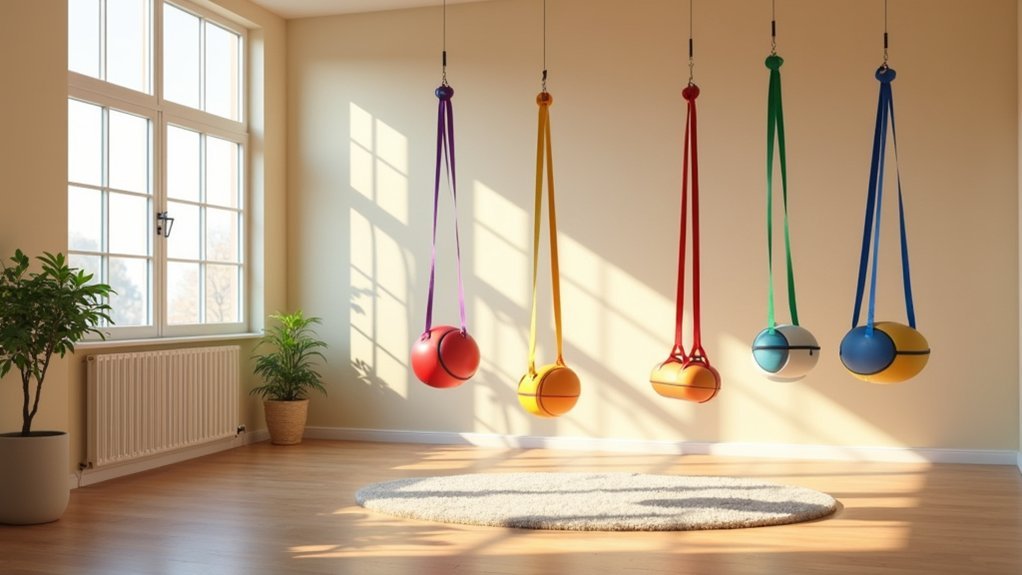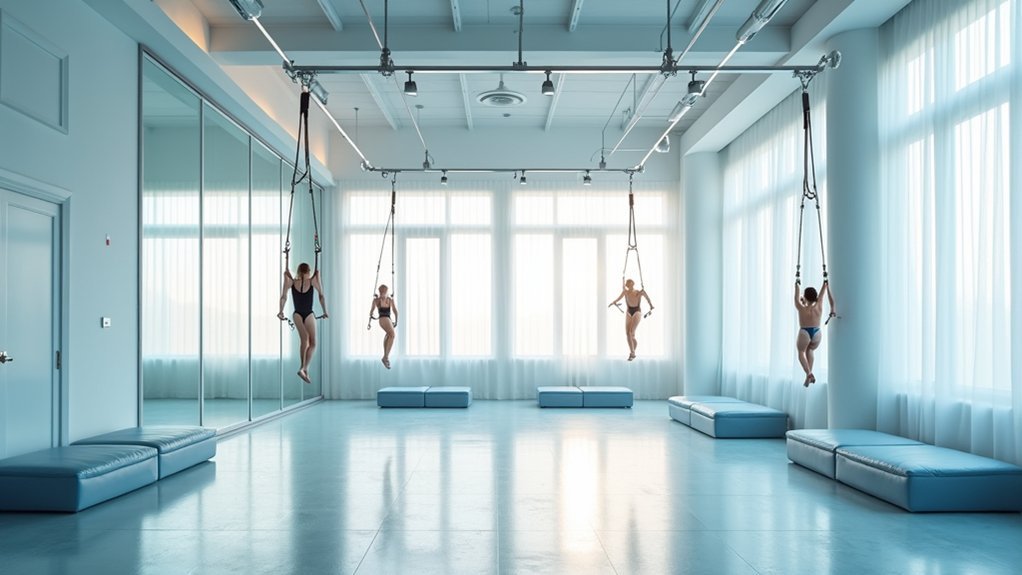Effective suspended equipment therapy spaces require careful planning with 6-foot clearances around swing zones and protective matting below. You’ll need 8-10 foot ceilings, adjustable equipment heights, and regular safety inspections. Design traffic patterns that allow smooth passages between therapy stations while maintaining clear sight lines for therapists. Balance active zones (swings, climbing ropes) with calming areas (hammocks, sensory mats) based on client needs. The right layout transforms therapeutic potential while ensuring both safety and engagement.
Creating Suspended Equipment Therapy Spaces That Work

When designing suspended equipment therapy spaces, you’ll need to balance safety requirements with therapeutic functionality to create an effective environment.
Start by guaranteeing a minimum 6-foot clearance around all swing perimeters and install protective matting underneath to prevent injuries during therapeutic movement activities.
Your space should feature adjustable height options to accommodate users of different sizes and abilities, making the environment inclusive for both children and adults.
Incorporate various suspended equipment types—hammocks, swings, climbing ropes, and aerial silks—to target different aspects of sensory integration and promote development of motor skills.
Don’t overlook maintenance requirements.
Schedule regular safety checks to verify all components remain secure and functional. This attention to detail guarantees your suspended equipment therapy space remains both safe and therapeutically beneficial.
Assessing Space Requirements for Suspended Equipment
You’ll need ceilings of at least 8-10 feet for safe suspended equipment therapy, preventing users from hitting their heads during activities.
Plan for smooth movement by maintaining a 6-foot clearance zone around all swing areas, creating buffer spaces that prevent collisions with walls or other equipment.
This thoughtful layout guarantees clients can shift naturally between different therapy stations while maximizing the therapeutic benefits of your suspended equipment.
Minimum Ceiling Height Needs
Evaluating the proper ceiling height stands as one of the most critical considerations when creating a suspended equipment therapy space.
You’ll need a minimum ceiling height of 8 to 10 feet to safely accommodate therapeutic swings and climbing apparatus. This measurement guarantees users can fully interact with the equipment without risk of injury.
Remember to factor in an additional 6 feet of clearance around the equipment’s perimeter to allow for natural movement patterns during therapy. Heavier suspended equipment typically requires higher ceilings for safe operation and ideal effectiveness.
Before installation, you should review local safety regulations and building codes, as they may specify required heights for your particular setting.
If you’re working with limited vertical space, consult a professional who can help maximize your layout while maintaining safety standards.
Flow Around Swing Zones
Beyond proper ceiling heights, the strategic planning of flow around swing zones directly impacts therapy effectiveness and safety. You’ll need to maintain a minimum 6-foot clearance around each swing’s perimeter to prevent collisions during therapy sessions.
| Zone Type | Clearance | Purpose | Material | Consideration |
|---|---|---|---|---|
| Swing Perimeter | 6 feet | Collision prevention | Open space | Unobstructed movement |
| Floor Protection | 6+ feet | Fall cushioning | Protective matting | Impact absorption |
| Ceiling Zone | Variable | Free movement | Reinforced mounts | Weight support |
| Supervision Area | Line-of-sight | Monitoring | Clear pathways | Therapist access |
| Multi-Equipment | Expanded | Multiple activities | Traffic patterns | Flow between zones |
When designing your therapy space, extend protective matting beyond the swing zone and arrange equipment to allow clear sight lines for supervising therapists. This thoughtful arrangement guarantees both safety and ideal therapeutic benefit during suspended equipment activities.
Safety Protocols and Weight-Bearing Considerations

When designing suspended equipment therapy spaces, prioritizing safety protocols is essential for preventing accidents and guaranteeing proper functionality.
You’ll need to maintain a minimum 6-foot clearance around all suspended equipment perimeters, creating adequate safety zones for users during therapy sessions.
Extend protective floor matting 6 feet from equipment boundaries to provide cushioned landing areas.
Safety first: protective matting should extend 6 feet beyond equipment zones to ensure cushioned landings during therapy.
Before installation, verify all components have been independently tested to support intended weight limits. Only use UL certified electronic components in your suspended setups to meet performance standards.
Don’t skip consulting with building maintenance experts when planning your installation.
They’ll confirm if your mounting hardware is compatible with the structural integrity of your space. Steel eye bolts and other mounting elements must be properly matched to your building’s construction to guarantee long-term safety and stability.
Selecting Therapeutic Suspended Equipment for Different Needs
Your therapeutic swing selection should begin with a clear assessment of each client’s sensory needs, whether they require vestibular input, calming enclosure, or motor skill development.
Choose equipment with proper weight ratings and safety certifications from independent testing labs to prevent accidents during therapy sessions.
You’ll want to include adjustable options like height-variable cocoon swings or trapeze bars that can be customized to accommodate different users and therapeutic goals.
Therapeutic Swing Selection Guide
Selecting the perfect therapeutic swing involves matching specific sensory needs with appropriate equipment designs. Consider whether your client would benefit from a cocoon-style swing for deep pressure input, a platform design for stability, or a hammock configuration for vestibular stimulation.
When choosing therapeutic swings, always factor in the user’s age, size, and specific sensory needs to guarantee both effectiveness and safety.
You’ll want to maintain safety standards by installing swings with at least 6 feet of clearance on all sides and protective floor matting underneath.
For enhanced sensory experiences, look for swings with additional features like sensory lights or sounds.
Don’t forget that regular maintenance checks are essential—inspect all components frequently to prevent wear and tear issues that could compromise your therapy outcomes.
Equipment Safety Considerations
Safety standards form the foundation of any therapeutic suspended equipment selection process. When you’re setting up suspended equipment therapy spaces, prioritize products that have UL certification and meet stringent testing from independent laboratories. This verification guarantees your equipment won’t fail during therapeutic use.
Always maintain proper clearance zones and protective flooring around your suspended equipment:
- Keep a minimum 6-foot clearance around all suspended equipment perimeters.
- Install shock-absorbing floor matting extending at least 6 feet from equipment.
- Perform regular inspections for signs of wear, damage, or loose components.
Don’t overlook the importance of consulting with building experts before installation. They’ll confirm your space can structurally support the equipment and that you’re complying with all safety regulations for suspended therapy equipment in educational or clinical settings.
Mounting Systems and Structural Requirements

Before installing any suspended therapy equipment, you’ll need to confirm that your mounting systems connect directly to structural supports capable of bearing both static weight and dynamic forces.
Always consult with structural engineers who can assess your ceiling’s load-bearing capacity and recommend appropriate hardware for your specific situation.
Professional guidance is essential—never install suspended therapy equipment without proper structural engineering assessment.
Maintain at least 6 feet of clearance around all suspended equipment to prevent accidents during therapy sessions.
Different equipment types require specific mounting considerations based on their design and intended use.
Don’t overlook this critical planning step.
Implement a regular inspection schedule to identify potential wear points or hardware failures before they become safety hazards.
These proactive measures confirm your mounting systems remain secure and your therapy space stays both functional and safe for all users.
Designing Multi-Sensory Experiences With Suspended Elements
While planning your suspended therapy space, consider how each element contributes to a cohesive sensory journey rather than functioning as isolated pieces.
Your multi-sensory rooms should strategically combine suspended equipment with complementary stimuli to address various sensory processing needs simultaneously.
Create spaces that allow children to engage their vestibular system while experiencing other sensory inputs.
You’ll want to make certain your design accommodates different intensity levels, from calming swinging motions to more active play opportunities.
- Pair hammocks with soft tactile elements and gentle sound machines for calming zones
- Position swings near visual elements like fiber optic curtains for enhanced engagement
- Include climbing elements connected to suspended equipment for complete motor development
Don’t forget to maintain proper clearance around all suspended equipment and use appropriate safety matting to protect active users.
Balancing Active and Calming Equipment Zones
Creating a harmonious therapy environment requires thoughtful separation of high-energy and low-arousal spaces within your suspended equipment setup.
When designing your therapy space, establish distinct active zones featuring swings, trampolines, and climbing structures that develop motor skills and encourage physical engagement.
Balance these with dedicated calming zones incorporating hammocks, sensory mats, and soft lighting where clients can decompress and regulate their emotions. This thoughtful arrangement facilitates natural shifts between stimulating activities and relaxation experiences.
Consider your clients’ unique sensory needs when determining the ratio of active to calming equipment.
Gather user feedback regularly to guarantee your space effectively supports individual therapy goals.
Implement flexible layouts that allow you to reconfigure equipment as needed, keeping the environment adaptable and engaging for diverse sensory preferences.
Adapting Suspended Equipment for Various Abilities
Successful therapy spaces must offer suspended equipment that accommodates clients of all abilities and needs. When designing your space, consider how each piece can be modified with adjustable heights, supportive harnesses, or specialized seating to guarantee safety and comfort for those with limited mobility.
Sensory integration opportunities expand when you customize swings and hammocks to provide both calming and stimulating experiences. Implement adaptive safety features like padded edges and soft flooring to minimize injury risks.
Three essential considerations when adapting suspended equipment:
- Install adjustable height systems that can be quickly modified between sessions.
- Incorporate supportive harnesses that maintain proper body alignment while allowing movement.
- Select equipment with various textures and resistances to address different sensory processing needs.
Maintenance and Inspection Schedules for Long-Term Use
To guarantee the ongoing safety and effectiveness of suspended equipment therapy spaces, you’ll need to implement rigorous maintenance protocols and consistent inspection schedules.
Conduct monthly inspections to identify wear, damage, or loose fittings that could compromise safety. Document all maintenance activities and inspection results to track equipment condition over time and spot concerning patterns.
Ensure all components—straps, swings, and attachments—meet safety standards, replacing any deteriorated items immediately.
Clean your equipment bi-weekly to prevent dirt and bacteria buildup that affects user health.
Don’t overlook staff training—proper maintenance depends on consistent implementation of safety protocols.
When your team understands correct usage and maintenance procedures, they’ll help extend equipment lifespan while maintaining ideal therapeutic conditions.
Frequently Asked Questions
How Do You Create a Sensory Safe Space?
To create a sensory safe space, choose a quiet area, use calming colors, add diverse sensory equipment, guarantee safety with soft flooring, and regularly adapt the space based on your users’ specific needs and feedback.
What Is the Snoezelen Area?
A Snoezelen area is your multi-sensory environment where you’ll experience controlled stimulation through lights, sounds, and textures. It’s designed to help you relax, explore sensory inputs, and regulate emotions in a safe space.
How to Create a Sensory Den?
To create a sensory den, you’ll need to choose a quiet space, use calming colors, add varied sensory equipment, guarantee accessible layout, incorporate adjustable lighting, and manage sound with soundproofing or gentle music.
How to Get Funding for a Sensory Room?
Apply to specialized foundations like Christopher Douglas Hidden Angel, Different Needz, and Flutie Foundation. You’ll find success by clearly outlining benefits, trying crowdfunding platforms, approaching local businesses, and seeking grants from organizations like IWPF.org.
In Summary
You’ve now got the tools to create effective suspended equipment therapy spaces. Remember you’ll need to consistently assess safety, properly anchor equipment, and maintain regular inspections. As you design your space, keep the balance between active and calming zones while adapting equipment for all abilities. With thoughtful planning, your suspended therapy environment will provide meaningful therapeutic experiences for years to come.





Leave a Reply